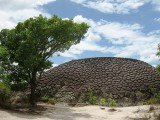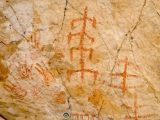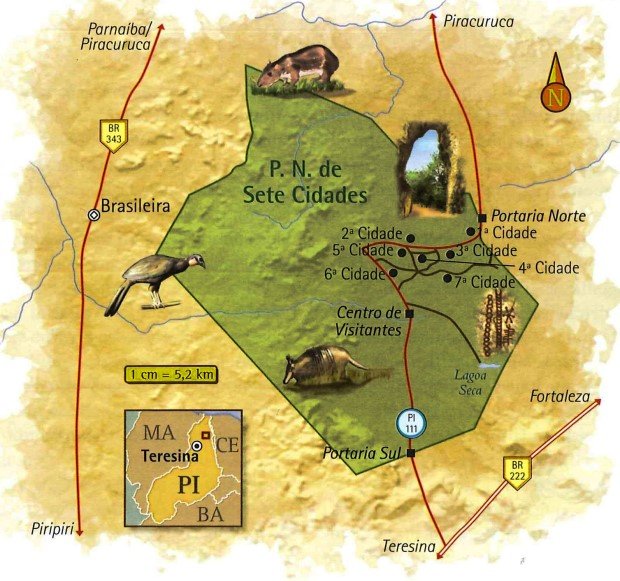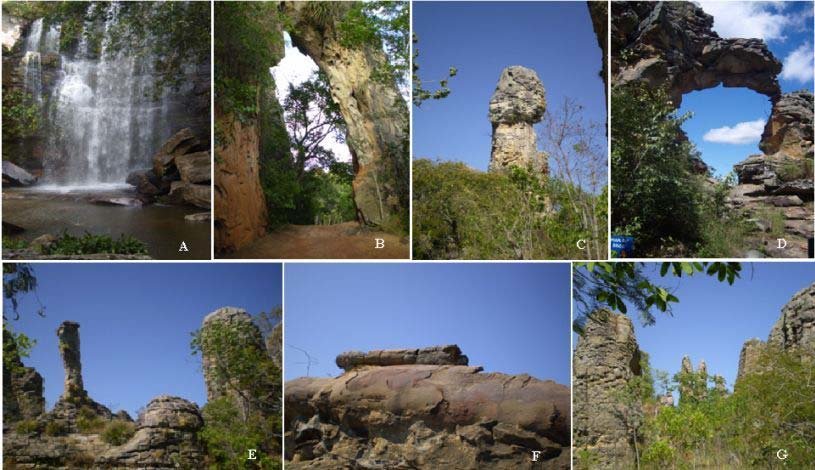Este post também está disponível em:
Português
English

The Sete Cidades National Park, in Piracuruca about 200 kilometers from Teresina in Piauí, is home to about 500 cave paintings on one of the large rock walls, which date back 6 to 10 thousand years and are preserved.
The Sete Cidades National Park in Piauí, created in 1961 and with more than 6 thousand hectares, is home to an extraordinary wealth of rock formations, rock art, fauna and flora.
In 6221 hectares of extension of the Parque Nacional de Sete Cidades, impressive geological monuments and a rare archaeological heritage are profiled, amid the fauna and flora of the transition area between the cerrado and the caatinga, the 22 springs and the many small water courses.
The first documents about the region date back to 1886, when Jácome Avelino, from Ceará, reported that “in a large plain, there is a place called Sete Cidades, which the adjacent inhabitants call enchanted, and they tell many versions of it that are nothing more than superstitions”.
To this day, there are several stories about Sete Cidades.

What is certain, however, is that the place is made up of sandstone rocks sculpted by the action of time and weather, and divided into six groups – or “cities”.
The general landscape can be appreciated from the viewpoint of the Second City: there, to the amazement of the traveler, one can see forms similar to roofs, chimneys, castles, fortresses, houses, as well as figures of animals and people, especially mysterious at dusk, when the rocks reflect golden tones in plays of light and shadows.
In addition to taking on impressive shapes, the rocks preserve rock inscriptions that are between 5 and 10 thousand years old: mixing shades of red and yellow, they represent geometric symbols and animals.
The fauna of the place includes the deer, the paca, the anteater, the iguana, the mocó, the armadillo, the agouti, the bush dog, and more than a hundred species of birds.
The vegetation, green from January to July, turns yellow during the dry season, from August to November.
Large trees such as pequi, bacuri, jatobá, pau-d’arco, angelim, sambaíba and c;uuí are easily seen.
In the dry areas, there are species typical of the caatinga, such as juazeiro, jurema, aroeira and cacti; near the springs, palm trees such as tucum, carnaúba and buriti grow.

It is possible to get to know the entire park by car, crossing its 12 kilometers of extension in a period of three hours, including breaks for small trails.
However, walking through Sete Cidades, in three or six hour itineraries, can be a beautiful adventure. There is also another option: rent a bicycle in the park itself.
For all alternatives, the tip is to take advantage of the early hours of the day, when the sun has not yet warmed up.
Hats, comfortable clothes, sneakers and sunscreen are important items, as well as snacks and water.
It is mandatory to be accompanied by guides accredited by Ibama.
The best way to visit the hill – traversed by the Prestes Column – is accompanied by local guides.
Video about “Sete Cidades” and “Pedro II City”


Sete Cidades no Piauí

Parque Nacional das Sete Cidades

Pedro II - A Cidade das Opalas

Parque Nacional das Sete Cidades - Reportagem
Tourist spots of the Sete Cidades National Park
1. FIRST CITY
Here is located the Riachão waterfall, with 21 meters of fall. The rocks resemble twisted cannons.
2. SECOND CITY
Richer in rock inscriptions. Here you will find the 18-meter-high rock known as the Arc de Triomphe (or Arch of Desire) and a 45-meter-high lookout point.
3. THIRD CITY
Here you will find the Map of Brazil, the Head of Dom Pedro I and the access to the Solsticial Hole trail, where the incidence of the winter sun (June) causes a special effect.
4. FOURTH CITY
Among the rocks, the one that resembles two lizards kissing and the one that resembles the map of Brazil stand out.
5. FIFTH CITY
Rich in rock inscriptions and rock monuments, it includes, among other formations, the furna do índio and the stones of the Camel and the Emperor.
6. SIXTH CITY
The greatest attraction is the perfect polygons that form the stone of the Turtle; there are also the stones of the Dog and the Elephant with its calf.
7. SEVENTH CITY
This is the place where the rock inscriptions are clearest, most of them in red. Among the impressive formations, the Casario and the Pajé cave stand out.
How to get there
From Teresina, access to the Sete Cidades National Park is via BR-343, following BR-222 to PI-111, which leads to the south gate.
Those coming from Parnaíba can reach the park through the north gate, passing through the city of Piracuruca (access via BR-343), 140 kilometers from Parnaíba;
Pedro II City – The City of Opals
Pedro II is a city in the state of Piauí. The city is located 208 km from the capital Teresina, more precisely in the north of the state. The city is located in the Serra dos Matões and is naturally privileged with a mild climate.
Old houses, colorful and well preserved, quiet and tree-lined streets and a cool mountain climate. Pedro II, nestled on the top of the Matões mountain range, about 600 meters above sea level, 50 kilometers from Piripiri (by BR-343), has all this and even more: it concentrates in its surroundings the only opal mines in South America.
Transparent or opaque, opal is a rare stone that, when exposed to sunlight, reflects the colors of the rainbow. In every corner of the city there are stores selling the gem. Among the best is Opalas Pedro II (Av. Cel. Cordeiro, 672, Centro).
In addition to mining, Pedro II stands out as a major producer of hammocks. The whole process of making them – from handloom to embroidery and sewing – can be followed closely at the Handicraft Workshop (Domingos Mourão Filho, 329, Centro).
But there are still other attractions, such as the Winter Festival, during the month of June, on the Corpus Christi holiday, with jazz and blues shows, and the hill of Gritador, from whose viewpoint at 720 meters high you can see Pedro II itself and its neighbor Piracuru.
See also Pedro II is a city full of history, precious stones and archaeological sites.
Sete Cidades National Park Tourism and Travel Guide



















